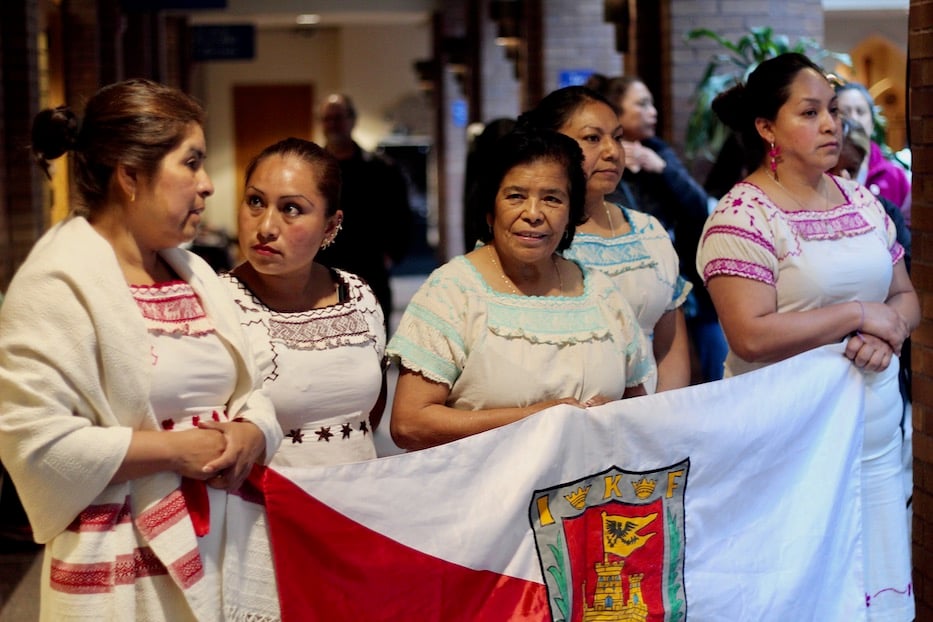
Culture & Community | Downtown | Immigration | Arts & Culture | New Haven Green | Unidad Latina en Acción | Arts & Anti-racism
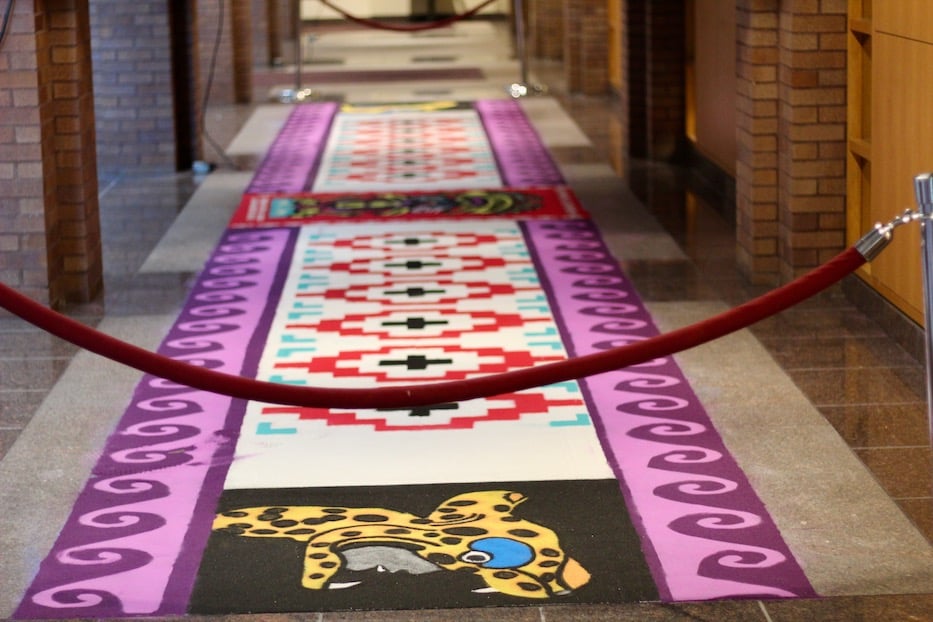
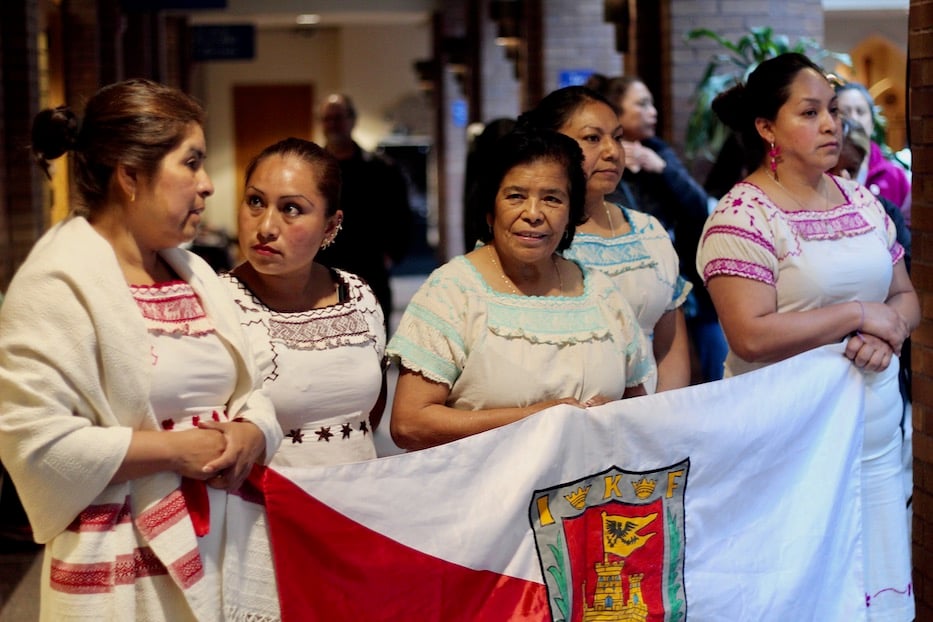
Top: Tomás Isaac Salazar’s sawdust carpet, or tapete de aserrín. Bottom: Members of Culturas del Pasado, Voces del Presente. The group presents in Spanish, English, and Náhuatl. Lucy Gellman Photos.
Editor's note: All Sunday activities have been moved to 26 Mill Street in New Haven's Fair Haven neighborhood because of rain.
At first, the design reveals itself in neat swirls of white and purple, waves of lilac and amethyst cresting at the base. Above it, bands of red and black arrange themselves into pre-Hispanic crosses, the color undulating beneath the light. In the center, a design explodes into red and yellow, showing a Tlaxcalan charro in traditional festive dress. The words Dia de la Hermandad float on a banner above, the color vibrating against the muted tile and carpet of City Hall.
Artist Tomás Isaac Salazar’s sawdust carpet, or tapete de aserrín, is a bright symbol of New Haven’s growing relationship with the Mexican state of Tlaxcala, from which a large population of New Haveners now hail. Wednesday evening, it marked the beginning of the city’s second annual Tlaxcala Friendship Day (Dia de la Hermandad), intended to open doors and spark conversation with Tlaxcalans in New Haven and abroad.
This year, Tlaxcala Friendship Day is in fact a series of days, each with their own activities fêting Tlaxcala. On Thursday, festivities continue with a street mural and exhibition at the New Haven People’s Center at 37 Howe St. On Friday night, there will be a Salterio Concert at Bregamos Community Theater. Then this weekend, artists will host traditional embroidery workshops, carnival, and a mobile mural on the New Haven Green.
A full schedule of events, with times and locations, is available here.
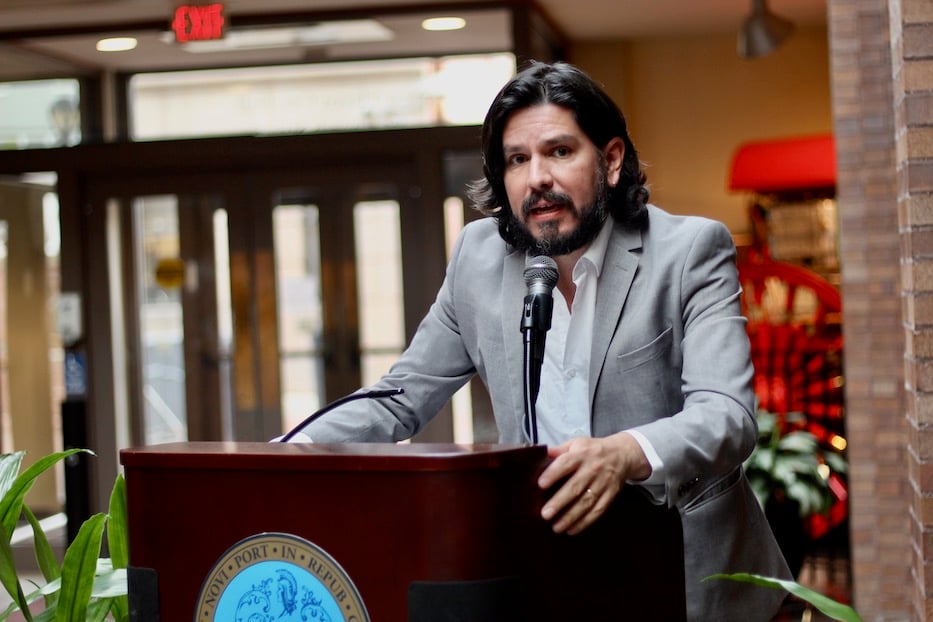
Marco Castillo.
“The people from Tlaxcala have been fundamental in the construction of what we now know as Mexico,” said Marco Castillo, board president of Casa Tlaxcala in New York City, alternating between English and Spanish as he spoke. “Since they founded what is today Tlaxcala, they have shown resilience, talent, intelligence, good hearts, community, and they are fierce warriors too.”
“It is with great joy that we celebrate today, the long-standing friendship and appreciation between the people of New Haven and the people of Tlaxcala,” said Tlaxcala Governor Lorena Cuéllar Cisneros in a release before the event. “Our two communities share an important part of their history, culture and our present and future is intertwined. We look forward to continuing our collaborations”.
It is a history decades in the making. Migrants from Tlaxcala began arriving in New Haven in the 1990s, for the promise of jobs. Initially, those were largely in construction, according to a 2016 piece in the New Haven Independent. Then construction gave way to the service industry, in which groups like Unidad Latina en Acción and the Semilla Collective are still fighting allegations of workplace abuse and wage theft.
In the years since that first wave of migrants, Casa Tlaxcala has recorded roughly 7,000 New Haveners who hail or have family from Tlaxcala. It has created a network of close-knit friend groups, specialty grocery stores, and traditions in the city that bridge a 2600-mile gap.
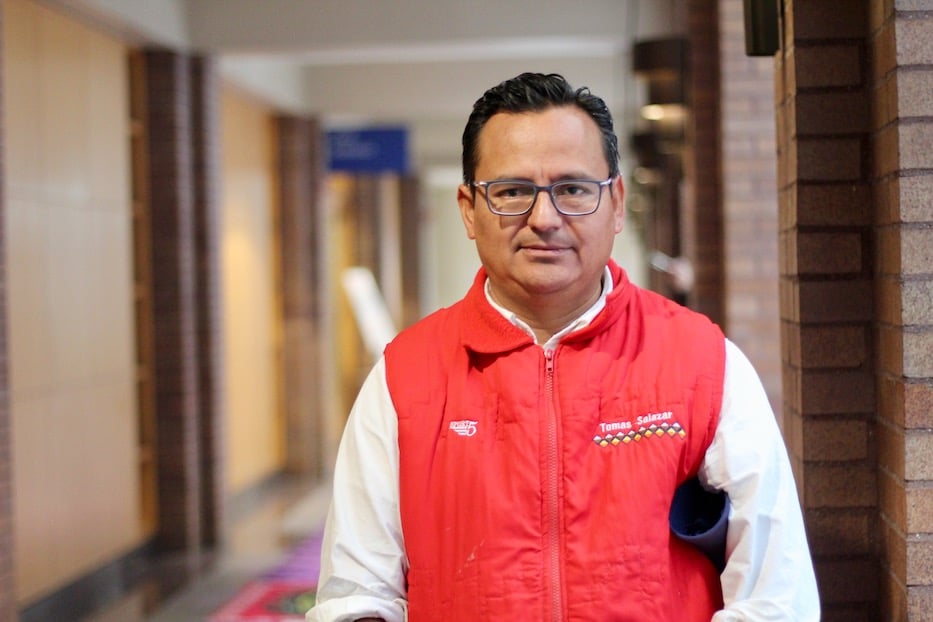
Salazar: "We want the people in New Haven to know more about the Tlaxcalan culture."
Throughout the evening, speakers stressed the role of arts and culture in bridging the distance between the two cities. Standing in front of the tapete de aserrín, Salazar teased out the meaning of each symbol, his hands fluttering through the air as he spoke. This week marked his first visit to New Haven, a city that he said he was excited to see.
In the center of the design, there is the image of a charro, a figure whose history and bright regalia has traveled from Tlaxcala and Puebla, Mexico to New Haven in decades of migration. Around him, red-and-black crosses multiply, in a nod to Indigenous, pre-Hispanic design. On each end, there are animals—a bird and a jaguar—that represent warriors from Cacaxtla, where the Olmeca-Xicalanca people once lived. At the base, cresting, purple waves “symbolize the continual movement of life,” he said.
For Salazar, who has spent his life in Huamantla, Tlaxcala, the carpet marks a moment of vital and overdue cultural exchange. Salazar comes from a long line of artists, he said Wednesday: he estimated that his family and community has been making art for almost a century. The carpet, for which the region is known, is part of arte efêmera—ephemeral art. Part of its draw is that it is visible for a few days, and then it is gone.
“I’m very proud because my job is going to open some doors,” he said. Behind him, the carpet stretched out in bright bands of color. “Especially because we want the people in New Haven to know more about the Tlaxcalan culture. This kind of work has been created in Huamantla for more than 100 years.”
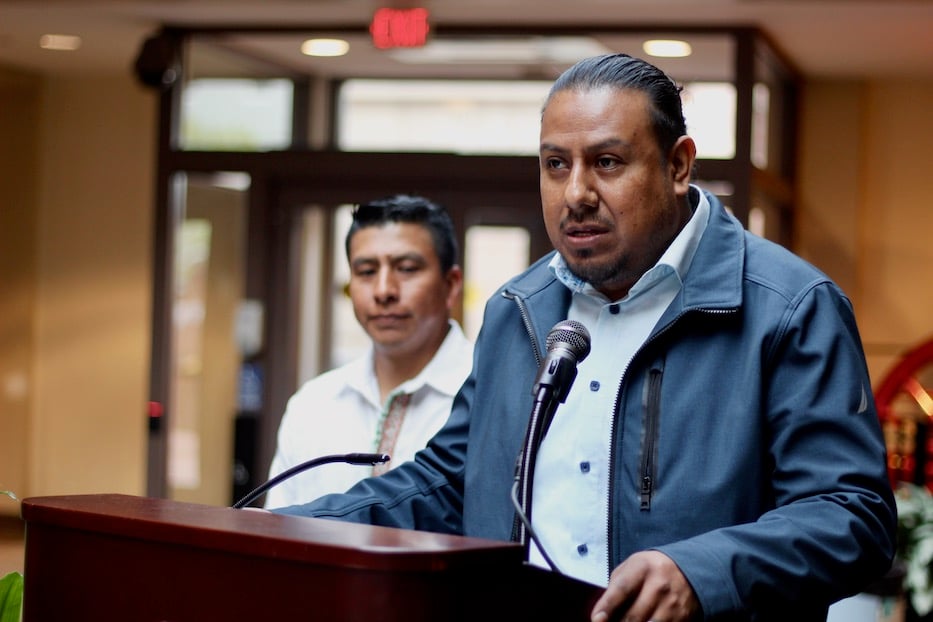
Speaker Javier Rodríguez.
Others looked to the contribution to New Haven that migrants, and particularly Tlaxcalans, have made since arriving in the city. Speaker Javier Rodríguez, who is originally from Tlaxcala and now lives in New York, pointed to the rich history and customs that Tlaxcalans have brought to New Haven, from their craft and too-often-undercompensated labor to their vibrant annual Carnival, which unfolds in the parking lot of Vendome.
“As migrants our daily struggles are countless, but our dreams are also countless,” he said in Spanish. “Dreams for which we organize, unite and shake hands in this territory that has welcomed us from kilometers away and sustains us through the strength of our work, with the hope of forging livable futures for our families. For our peoples, who saw us born, our hearts are there.”
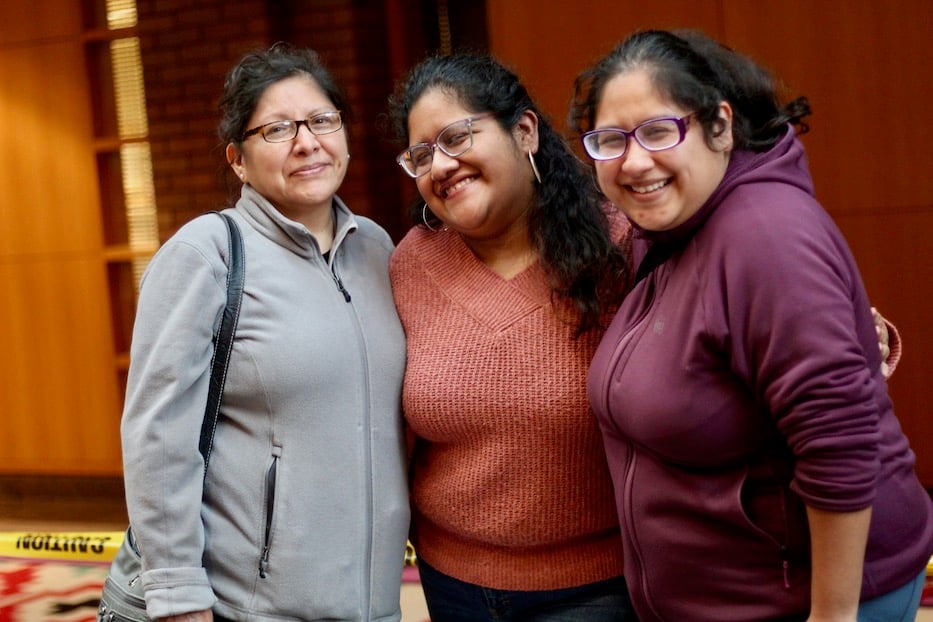
Melba Perez with her daughters, Sandy and Melba Flores.
As she listened with her daughters Melba and Sandy Flores, Melba Perez let the words wash over her, comforting as speaker after speaker filled City Hall in warm, sometimes laughter-flecked Spanish that felt like being home. Around them, City Hall’s atrium filled with fellow migrants, the sound traveling to the high ceiling and back down again. Every so often, city officials and New Haveners there for meetings looked down curiously from the second floor.
In 1995, Perez came to New Haven with a group of fellow Tlaxcalan migrants, headed for what they thought was New York. When she realized that she was in fact in Connecticut—a story she later passed down to her daughters—she stayed. One year after arriving, her first daughter was born, and she began to build a life in New Haven.
While she loves the life she has built, Tlaxcala will always be her first home, she said (when she is homesick, cooking is her go-to activity, with a mole that makes her feel closer to Mexico). Wednesday, she noted how at ease and welcomed she felt among dozens of people who shared her story.
“It’s amazing,” she said. “I feel like I’m at home, but far away.”
For her daughters, who grew up in New Haven and are now 22 and 26, it also marked an acknowledgement and celebration of the city’s multiculturalism that was unlike anything they experienced as young children. Melba Flores, who is now 26 and works in early childhood education, remembered growing up at a time when her Spanish—especially in school—was frowned upon.
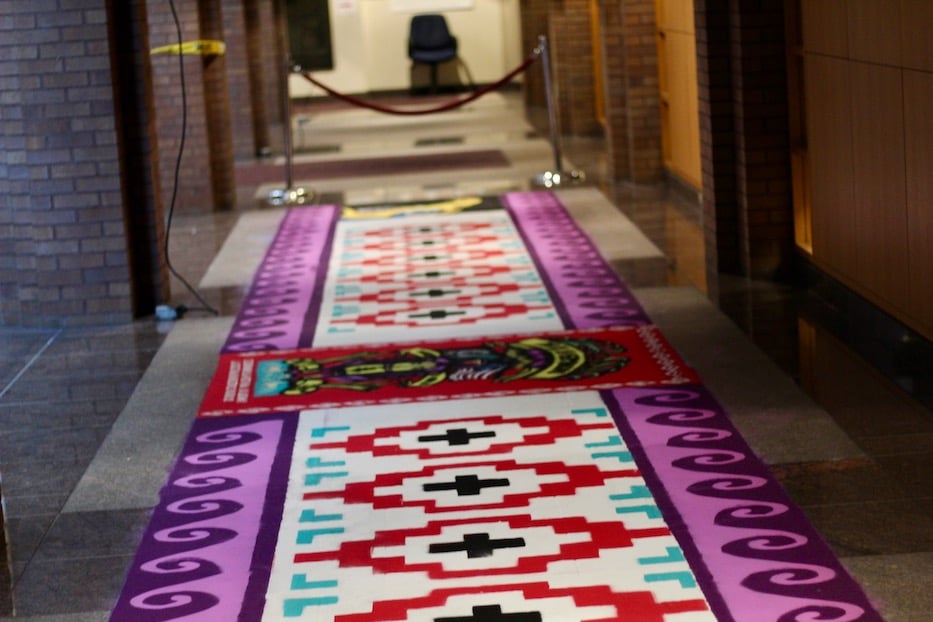
Because of it, she let herself assimilate. For years, “I didn’t really care about the connection to Tlaxcala,” she said. Sandy agreed, adding that for a time, “growing up in the U.S. made me forget my roots.”
That changed when Melba was in college seven years ago, at a small liberal arts school in Michigan, and was able to visit her grandparents in Mexico for the first time. During her study abroad program, she returned to Mexico, and realized how far away she’d been. Now, she teaches her preschool students different Spanish words and sings songs with them in Spanish.
“That’s why this event is really important,” she said. “It’s seeing people who look like you.”
Across the atrium, the women of Culturas del Pasado, Voces del Presente held the red-and-white flag of Tlaxcala, a bird spreading its wings wide at the top. In the front of City Hall, members of the group set up a small Tlaxcalan marketplace, with bright embroidery and bouquets of delicate, vibrant paper flowers. The group, which has members who live in both Tlaxcala and New Haven, was born as both a vehicle for cultural exchange and family reunification.
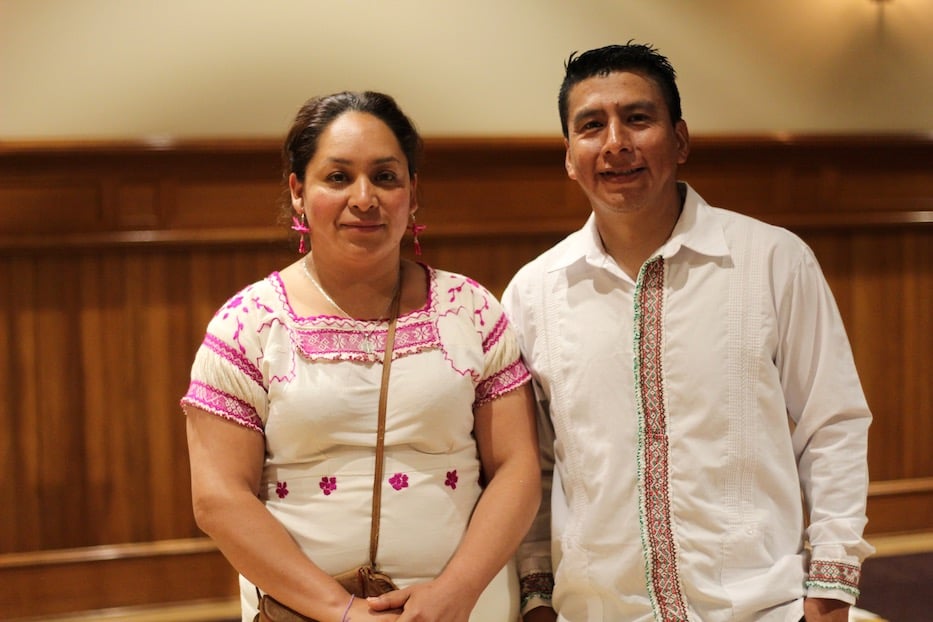
Griselle Bello and Pedro Espinosa Morales.
Husband and wife Pedro Espinosa Morales and Griselle Bello, who both hail from Tlaxcala and now live on separate sides of the border, are an example of that. Over two decades ago, Morales migrated to New Haven in search of work opportunities. At the same time, Bello remained in Tlaxcala. The exchange allows them to travel between the two places more freely.
In her role, Bello has worked to keep Indigenous Tlaxcaltec customs alive, from folk dances to to an observance of Día de Muertos that came to the Green last year. With groups like Unidad Latina en Acción, meanwhile, Morales has become a fierce advocate for fellow immigrants in this country.
For him, citywide gestures like Tlaxcala Friendship Day are a chance for Tlaxcalans across the city to come together, particularly after what he has seen of years of divisions.
“Since the beginning of time, our people have traveled without borders,” he said in Spanish as organizer Megan Fountain translated. “We migrated, we moved around the continent, we had exchanges with other peoples and other cultures without borders. The borders were imposed by the current government only recently.”
“When we migrate here to New Haven, we don’t migrate alone,” he added. “We bring with us our traditions, our cultures, and our roots. What we’re doing today is very important because we’re uniting all the people of Tlaxcala who live in New Haven who have been very divided. What we’re trying to do is bring together all the people from Tlaxcala.”
Programming for Dia de la Hermandad runs through Sunday and includes a concert Friday night and a carnival on the New Haven Green this weekend. A full schedule of events, with times and locations, is available here.

